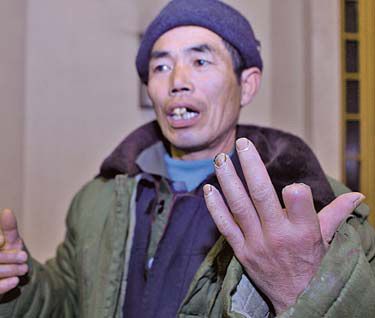Government and Policy
Injured laborers unaware of free rehab
Updated: 2011-01-25 08:03
By Li Li (China Daily)
Limited resources and lack of promotion blamed for underused centers as migrant workers left unattended. Li Li in Beijing reports.
 |
|
Migrant worker Dai Zhengsheng displays the hand he injured on a Beijing construction site in November in this photo taken last week. [Photo/China Daily] |
Dai Zhengsheng lost his left forefinger in November when he slipped using an electric motor saw at a Beijing construction site.
"I used to lay the neatest brick floors," said the 56-year-old. "Now, I can barely put my own clothes on."
Like other migrant laborers who suffer injuries on the job, Dai is eligible for the State's free rehabilitation program. Yet, he rejected the offer for fear it will affect the process of getting compensation from his employer.
Although Dai refused rehab treatment, experts say the majority of people - particularly migrant workers - do not even know it is available.
In fact, so few have taken up the offer that the Industrial Injury Insurance Fund, which was set up in 2004 and can be used for rehab services, had a surplus of 44 billion yuan ($6.68 billion) as of September 2010.
China has 338 medical clinics that offer rehabilitation, including 35 experimental industrial injury centers certified by the Ministry of Human Resources and Social Security. The network is made up of about 50,000 beds and 40,000 health professionals, according to 2010 figures from the Ministry of Health.
This means the system can provide two-month treatments to 300,000 people at any one time, said Tang Dan, president of Guangdong province's Work Injury Rehabilitation Center in Guangzhou.
However, with 1 million laborers suffering new injuries every year and many others affected by recurring ailments, Tang estimates more than 400,000 people are in need of rehab services. "The country's demand for industrial injury rehab greatly surpasses supply, but few are actually receiving it," he added.
Results of a survey published this month show almost all 73 laborers interviewed in Beijing suffered "minor injuries" that could be improved by rehabilitation. "None received any because they didn't know about it," said Shi Fumao, director of the Zhicheng Legal Support Center for Migrant Workers, which carried out the poll.
Back on two feet
Delivery driver Ban Jiyuan suffered fractures to his pelvis and thighs in a traffic accident on his way to work in Guangzhou last August. He feared he would never walk again.
"When I returned home from the hospital after the surgery, I didn't know how to walk properly," said the 38-year-old.
After filing a report on his injuries, his employers sent him to Guangdong's Work Injury Rehabilitation Center, where after a month of professional physiotherapy he was able to walk with the use of crutches. "The doctors told me I should be able to walk unaided in two to three months," he said.
On top of the physical help, Ban, who hails from Guizhou province, has also been able to learn computer skills to help boost his job prospects. (His boss has offered him work after he is discharged.)
Opened in 2001, the Guangzhou center is the first and largest facility of its kind on the Chinese mainland. It can treat up to 200 workers a time and offers a range of services, from physiotherapy and occupational therapy to speech therapy and psychological counseling.
Guangdong's authorities are leading the way in industrial injury rehabilitation. Unlike in other provinces, health professionals from the center regularly visit hospitals to evaluate potential claimants and actively promote rehabilitation services. (Some admitted that hospitals can be uncooperative as they "see us as thieves stealing their business".)
"Early rehabilitation is better for a patient's recovery," said Tang, president of the center. "We help pave the way for workers to return to their families and employment."
With 43 work stations built to simulate environments for various professions, such as drivers, waiters, electricians and cooks, patients are given practical training to cope with their injuries on a daily basis.
"We design training programs according to jobs," said Luo Xiaoyuan, director of work and social rehab at the center. "For example, if the patient is a postman, we will add more lifting, pushing and pulling exercises to his training."
Workers often return to companies for trials, with regular evaluations to ensure they are progressing well, while the center will also carry out home modifications for patients with long-term mobility problems.
"We build a file for each patient and follow up with phone calls for six months," said Luo. "Our door is always open whenever they need any help."
Roughly 78 percent of the clinic's patients have returned to work in the past three years. To replicate this success, Tang's staff members now provide technical support to bases in other cities and provinces.
"Every year we receive different experts from Guangdong to instruct our work," said rehab executive Zhan Lifang at Boai Hospital, the only dedicated industrial injury rehab facility in Hunan province. "In 2009, we had a re-employment rate of more than 50 percent."
Specials

President Hu visits the US
President Hu Jintao is on a state visit to the US from Jan 18 to 21.

Ancient life
The discovery of the fossile of a female pterosaur nicknamed as Mrs T and her un-laid egg are shedding new light on ancient mysteries.

Economic Figures
China's GDP growth jumped 10.3 percent year-on-year in 2010, boosted by a faster-than-expected 9.8 percent expansion in the fourth quarter.




